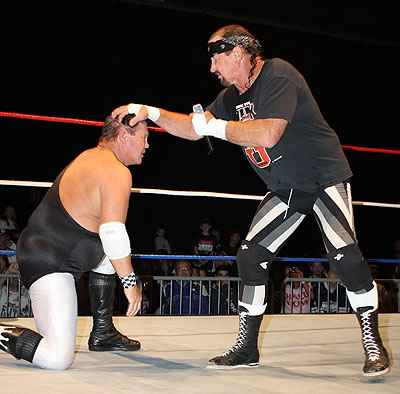Suffering, Defeat, and Justice: Why You Should Care About Pro Wrestling
Published on January 30th, 2012 in: Issues, Oh No You Didn't, Pro Wrestling, Sports, TV |ECW and modern promotions, like Ring of Honor (ROH) and Combat Zone Wrestling, are all ostensibly reactions against the public admission that wrestling is “fake.” With the cloak of mystery now revealing the bones and flesh of the business, Heyman—and then Bischoff and McMahon who quickly caught on—felt that more blood, more risk of real injury, and more sex were the way to address what they had lost in audience investment. For a time this was more than enough to compensate. You could not fake falling fifteen feet and crashing into a table without putting your life at risk. Having your face cut up by barbed wire or falling on thumb tacks was equally convincing to people who had previously held uninformed views on the dangers of professional wrestling. “His ear is hanging off! How could they fake that?” The answer: They didn’t.

Jerry Lawler, Terry Funk
The problem with going this route, as Jim Cornette says above, is one of diminishing returns. In the space of about five years, the standard level of risk in a televised wrestling match had increased probably a hundred times from a decade earlier. And it was getting a fraction of the reaction. There were artists in violence: Terry Funk, Mick Foley, Sabu. These men could reveal the art form underneath the blood and use it as it always should be, as an element in a compelling story. Unfortunately the negative effects are not constrained to the homogenization of the way stories are told. They have, somewhat obviously, shortened careers and endangered lives.
It cannot rightly be argued that an individual like Chris Benoit—the man who murdered his wife and son, then killed himself—was not negatively impacted in regards to his mental and physical state by the dozens of concussions he suffered at the hands of a very impact-heavy style. The spate of deaths in professional wrestling in the last ten years is shocking, even for the casual observer, and it is specious to suggest that the core reality of modern professional wrestling has nothing to do with the string of eerily similar circumstances in which wrestlers die. Heart conditions, suicide, drugs. Even Hollywood would have a hard time comparing with the callous indifference which the pro-wrestling industry has shown to former stars—former cash cows—when their numbers come up and their bodies are too beaten to be of any use.
World Wrestling Entertainment is now delivering a PG product, from television shows to Pay Per Views. Again, this is a business decision and not simply a reaction to the issues detailed above. It is interesting though, how there is currently a concentrated effort to shift the parameters of the audience back a couple of decades. As far as expectations of violence go, I don’t believe this is possible to do, especially not while the competition—Total Nonstop Action Wrestling and ROH—continue to deliver a violent product. WWE is highlighting a crucial difference between the audiences of the 1980s and those of today. This can be defined as the ability of the individual to actively engage in the story being told.
Time limit is exhausted. Please reload the CAPTCHA.